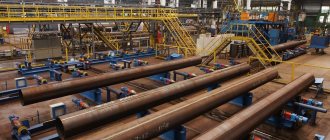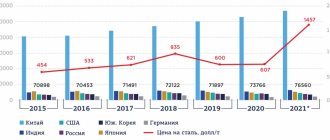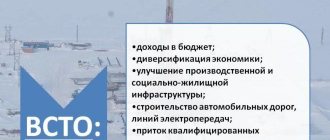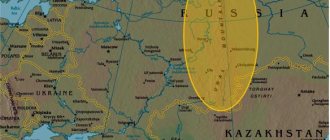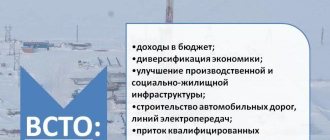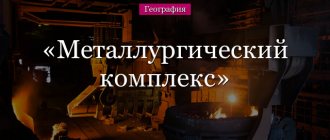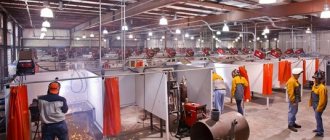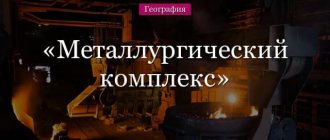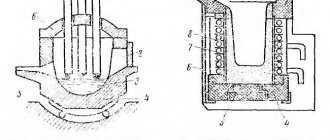Any state strives to develop its economy and increase its defense capability. To solve these problems, machines, equipment, military and civilian equipment, aircraft, and sea vessels are needed. The engineering industry is engaged in the production of machinery and equipment. The raw materials for the manufacture of mechanical engineering products are ferrous and non-ferrous metals.
Therefore, the metallurgical industry, which provides all others with raw materials, is the basis for the well-being of the state in the economic sphere and in maintaining defense capability.
Concept of metallurgical base
Obtaining metal products is a complex task for a number of industries from mining to smelting. The merging into a coherent structure of various closely interrelated industries and the end product of their activity is metal, forms a metallurgical base.
The specifics of metallurgical production and its location are determined by the dependence:
- From coal;
- From metal ores;
- From having enough energy;
- From the presence of highly qualified workers and employees.
To produce one unit of metal, tens or hundreds of units of ore rocks may be required. Therefore, transporting ore to the processing site is not economically feasible; it is more practical to build a plant in the center of ore deposits and transport the necessary coal to it, build a powerful power plant, and expand local towns for the residence of metallurgical plant workers.
Based on this, metallurgical bases in Russia arose in areas with a high content of metal ores. Since ancient times, such regions have been the most powerful iron ore basin in the world - a magnetic anomaly in the Kursk region and the ridge of the old Ural Mountains. During the development of the Soviet Union, a relatively young metallurgy base in Siberia began to be developed.
Metallurgy is divided into:
- Ferrous, processing ore and non-metallic raw materials;
- Non-ferrous, producing light and heavy metals. Non-ferrous metallurgy also includes the production of precious metals - gold, silver and platinum, as well as rare ones such as molybdenum, zirconium, tungsten, indium and others.
Ferrous metallurgy comprehensively includes coal mining and coking, mining and processing of iron ores, production of refractories and other related industries. The main consumers of ferrous metallurgy products are enterprises producing large metal structures for construction, enterprises of the electric power complex and metal-intensive mechanical engineering.
Non-ferrous metallurgy extracts and enriches ores, smelts heavy, light, precious and rare non-ferrous metals.
Non-ferrous metallurgy
Based on their purpose and chemical and physical characteristics and properties, non-ferrous metals are divided into:
- Heavy (copper, lead, tin, zinc, nickel);
- Lightweight (aluminum, titanium, magnesium);
- Precious (gold, silver, platinum);
- Rare (zirconium, indium, tungsten, molybdenum, etc.)
Non-ferrous metallurgy is a complex of enterprises that is engaged in the extraction, enrichment and metallurgical processing of non-ferrous, precious and rare metal ores.
In this chain, aluminum, copper, lead-zinc, tungsten-molybdenum and titanium-magnesium industries are distinguished. In addition, this also includes enterprises producing precious and rare metals.
The largest metallurgical bases in Russia
Since the times of the empire, Russia has been and continues to be a leading producer of ferrous metals, which is due to reserves and placement of ore reserves, and today the country is not going to give up its leadership to other states.
In modern Russia, 3 main metallurgical bases develop and produce their products:
- Central;
- Ural;
- Siberian.
These nodes for the extraction and processing of metal ores are large not only in the country, but also abroad, and make Russia one of the leaders in the world metallurgy. The country produces over 6% of the world's iron, 12% of aluminum, 22% of nickel and 28% of titanium. Without these metals, it is impossible to build cars, ships, planes, or rockets in the modern world.
The largest factories are located in the cities of Magnitogorsk, Chelyabinsk and Asha, Nizhny Tagil, Stary Oskol, Beloretsk, Chusovoy.
Central metallurgical base
Iron ore reserves underlie Russia's oldest metallurgical base. The deposits are located no deeper than 800 meters, that is, at a shallow depth, allowing for open-pit mining, which significantly reduces costs. The basis for the development of metallurgy is the Kursk magnetic anomaly, rich in iron ore deposits. Coking coal is delivered from the Donbass, Pechersk and Kuznetsk coal basins.
The centers for the location of cyclical metal production plants are located in the cities of Stary Oskol, Lipetsk, Tula, Cherepovets. In addition to the extraction and processing of ores, the enterprises of the central metallurgical base actively smelt scrap metals. Pipe metallurgy plants are located in the cities of Moscow, Orel, Elektrostal, St. Petersburg, and Nizhny Novgorod. The Oskol Metallurgical Plant has an interesting feature - it launched a smelting method without the use of blast furnaces, the process is carried out using electricity.
Non-ferrous metallurgy enterprises are located in the cities of Volkhov, Nadvoitsy, Kandalaksha and Monchegorsk.
Ural metallurgical base
The main base for the production of metals, both ferrous and non-ferrous, is the Urals. The Ural metallurgical base is the largest not only in Russia, but also the most powerful on a European and global scale. A distinctive feature of the flagship of Russian metallurgy can be considered the high concentration of production. The oldest city of glory for Ural metallurgists is Magnitogorsk, where the famous metallurgical plant is located. Magnitogorsk produced more than half of all ferrous metals in the former Soviet Union.
The Magnitogorsk plant is located in the center of the raw material bases of the Urals and Norilsk, coal mines of Kuzbass and Eastern Siberia.
Today, enterprises of the Ural metallurgical complex are undergoing modernization for successful development in the future to increase capacity.
Siberian metallurgical base
Russia's relatively recently developed metallurgical base is located in Siberia. Siberian metallurgy developed during the USSR period. The centers are located in the cities of Kuznetsk and Novokuznetsk. The products of the Novokuznetsk plant are famous for their high quality. In addition to traditional centers, there are the West Siberian plant and a number of processing enterprises of the Novosibirsk, Sibelektrostal, Guryevsky and Petrovsk-Zabaikalsky plants.
The metallurgy of the Siberian region is supplied with coal from Kuzbass and processes iron ore deposits of the Angara-Ilim basin, Gorona Shoria and Khakassia. The development of metallurgy in Siberia is gaining momentum, and new centers of primary and final smelting may appear.
Problems and prospects
There are problems in every industry. The metallurgical complex is no exception. Among the main problems of ferrous and non-ferrous metallurgy, the following can be identified:
- high energy consumption;
- low capacity of the domestic market;
- high level of depreciation of fixed production assets;
- shortage of certain types of raw materials;
- destruction of the process of reproduction of raw materials and ore reserves;
- technological backwardness and insufficient introduction of new technologies;
- shortage of professional personnel.
Read also: Tensile strength of steel formula
But all these issues can be resolved. Russia continues to be a major player in the global metallurgical products market. The share of Russian metallurgy in world production accounts for more than 5% of steel, 11% of aluminum, 21% of nickel, and more than 27% of titanium. The main indicator of the competitiveness of Russian metallurgy on the foreign market is that the country maintains and even expands its export capabilities.
The current state of the domestic metallurgy complex
The situation in Russia's oldest industry is assessed as difficult. Despite low production costs compared to other metal-producing countries, there are tendencies to delay production rates and financial problems. In the last decade, a number of plants have been shut down.
Since the crisis of 2009, there has been a decline in aluminum production, despite the fact that its consumption in other industrialized countries of the world is many times higher than the demand in ours. With fairly high prices for metals and an increase in their consumption in the world, the financial and economic situation of Russian metallurgical enterprises is deteriorating.
Overview of the global steel market
The COVID-19 pandemic has had a significant impact on the global steel industry in 2022.
High uncertainty, the introduction of restrictive measures to curb the spread of infection, partial suspension of production chains and turbulence in commodity markets have led to significant imbalances in the balance of supply and demand, which also changed the structure of global trade flows in all key regions. In 2022, the global economy was subject to sharp fluctuations in market conditions. The metallurgical products market was no exception: the most sensitive blow for manufacturers was the sharp decline in demand for their products caused by the introduction of measures to counteract coronavirus infection and, as a result, the suspension of production, construction projects, etc. in China, and then in others countries. As a result, the price of steel began to fall in the first quarter of 2020. As China's economy recovered, from May 2022 the trend began to change to positive, and in the third quarter there was a fairly sharp acceleration in growth, which continued at the beginning of 2022 (Fig. 1).
Rice. 1. Dynamics of steel production volumes in the TOP 7 countries, thousand tons (left axis) and average annual steel price in 2015–2021, dollars/t (right axis)
Source: LME, WorldSteel
During the restrictive measures related to the spread of coronavirus infection, due to a drop in demand for metallurgical products in many producing countries, blast furnaces and converters were closed, which was the reason for such dynamics.
The first country where business activity began to recover was China. A large-scale government program to stimulate the economy and finance large infrastructure projects contributed to a sharp increase in domestic demand for steel products and subsequently increased prices for steel products around the world (Fig. 2).
Rice. 2. Structure of steel production by region for 2022, %
Source: Bloomberg
According to the Worldsteel Association, global steel production in 2020 decreased by 1% y/y, to 1.83 billion tons, which was almost completely offset by the record volume of steel production in China (+8% y/y, up to 1.05 billion tons). The utilization of steelmaking capacity in the world averaged 82% (Fig. 3).
Rice. 3. Dynamics of global steel production, billion tons
Source: Bloomberg, Worldsteel
Amid the crisis associated with the pandemic, global steel demand fell by 2.4% in 2022. Demand in the eurozone fell by 15.2%, while steel consumption in India fell by 20.2%. In response to the decline in demand, the operation of blast furnaces with a total capacity of about 70 million tons was suspended.
Steel production in the United States in 2022 decreased by 17% year-on-year, to 73 million tons. Average capacity utilization was 67% and was below the pre-crisis level at the end of the reporting period. Steel consumption in 2020 decreased by 19% YoY, to 86 million tons, amid limited supply from producers due to the COVID-19 pandemic. At the end of the reporting period, there was a revival in demand in the automotive and construction sectors, but the lead times of orders by steel producers were at historically high levels: preference was given to long-term contracts, while the supply of steel on the spot market was practically absent. Imports of steel products at the end of the year decreased by 21% y/y, to 20 million tons, exports - by 4% y/y, to 6 million tons.
In the EU countries, steel production decreased by 12% year-on-year, to 139 million tons. By the end of 2022, monthly production volumes almost reached pre-crisis levels amid high production profitability. Capacity utilization dropped to almost 50% during the pandemic, but recovered to 70% by the end of the reporting period. Apparent consumption of steel products in the EU in 2022 fell by 12% YoY, to 142 million tons, amid weak demand caused by the COVID-19 pandemic and forced shutdowns. At the end of the reporting period, there was a revival in demand in the automotive and engineering sectors. Imports of flat rolled products decreased by 17% y/y, to 21 million tons, exports - by 13% y/y, to 18 million tons.
During the pandemic, China managed to successfully contain the spread of the virus, while other countries faced high infection rates and were forced to impose strict quarantine measures until mid-May 2022. While apparent demand in the world decreased by 2% y/y, to 1.75 billion tons, in China it increased by 8% y/y, to 1.05 billion tons. At the same time, exports from China decreased by 17% y/y, up to 54 million tons (Fig. 4).
Rice. 4. Export of metal products from China, million tons
Source: Bloomberg, Worldsteel
In 2022, China became a net importer of steel for the first time since 2009. This contributed to rising steel prices in Southeast Asia (Fig. 5).
Rice. 5. Volumes of steel exports and imports in China, million tons
Source: Worldsteel
Steel demand fell sharply in the second quarter, but pent-up demand accelerated growth in the third and fourth quarters of 2022 as strict lockdown restrictions eased. In the second half of 2022, the metal products market entered a recovery phase, dictated by pent-up demand and high prices for raw materials. At the same time, steel mills began to restart idled blast furnaces.
Already in January-May 2022, global steel production amounted to 837.5 million tons (+14.5% compared to the level of the comparable period in 2022). In North America, steel production increased by 11.3% to 48.4 million tons, in the EU (27) - by 15.3% to 64.4 million tons, in Africa - by 24.4% to 6.5 million tons, in Asia - by 14.9% to 616.5 million tons, in South America - by 24.1% to 18.7 million tons, in European countries outside the EU - by 17.3 % to 20.9 million tons, in the Middle East - by 8.1% to 17.8 million tons.
In general, developed markets, where the service sector occupies a significant share of GDP, were hit the hardest by the crisis. In 2022, due to two waves of COVID-19, GDP growth slowed in the US (from 2.2% in 2022 to -3.4%) and the EU (from 1.3% in 2022 to -7.2%) . Developing countries have also felt the effects of the crisis. Due to strict quarantine measures, India's GDP decreased by 8% in 2020. China's GDP growth fell to 2.3% in 2022 (from 6% in 2019) thanks to fiscal stimulus measures and effective virus containment.
Problems of the Russian metallurgical industry
The difficulties of domestic metallurgists lie not so much in the industry itself, but in the general economic situation and are systemic in nature. Such a discrepancy, when metal resellers have a positive result, and the industry itself is at a loss, should not exist, but for now this paradox exists. The pursuit of short-term profit without solving the problems of investing profits in modernization and innovation leads to the complete destruction of leading sectors of the economy.
The country's existing mineral reserves for metallurgy are not used efficiently, and manufactured products are increasingly beginning to reach consumers of poor quality. This is evidenced by the recent major accidents at construction sites with a large number of metal structures and on pipelines.
In Russia, more metal products are produced than the needs of the domestic market. 35 million tons of finished products and more than 30 million tons of raw materials are exported. At the same time, the available capacities are not even half loaded. The paradox is that in highly developed economies of the world they produce expensive products, but in Russia they are not produced for various reasons. With sufficient resources and demand, the products of Russian metallurgists remain at quality parameters that do not meet the requirements of consumers. More than 90% of the cast iron produced is exported, and more than 60% of the total demand for rolled products with various coatings, metal structures and other finished metal products is imported.
Another paradox is that imported metal is twice as expensive as the cost of exported metal. This reflects the quality of the product. Russian manufacturers need to work towards improving the consumer characteristics of metal and deep processing aimed at producing metal products that are in demand.
One of the problems of the modern metallurgical industry is the destruction of the relationship between metal production and investment development. There is a demand for metal products that domestic manufacturers cannot yet satisfy.
The state of metallurgy in Russia is influenced by interconnected complexes and limitations of such blocks:
- International trade;
- The position of the leaders of the domestic economy;
- State of the investment base.
The limitations of these blocks determine the insufficiently high growth rates of steel production in Russia.
Industrial Russian centers
Centers of this kind are united into metallurgical bases - groups of factories that are actively working in this direction. Today there are three main ones:
- Siberian;
- Ural;
- Central.
Each base has its own characteristics. They differ from each other according to a number of criteria. The most significant, of course, is the type of ore. As you know, there are quite a large number of varieties of this raw material. Also, each base has its own capacity, and the structure of work organization is different. As a result, production capacity changes.
The youngest group is Siberian. It is still being formed. But it is worth noting that development is quite active. The main role in this process is played by Khakassia, as well as South Yakutia. The Ural region is distinguished by its diverse and well-developed structure. The Urals are rich in sources, so this area is developing here easily and actively. But maximum activity in the production of ferrous metals occurs in the Central Base. The main regions in this case are Belgorod and Kursk.
If we consider the transport centers of Russia, the cities and the list will be different. Today, the main types of transport used are road, air and rail. Moscow should be included in the top cities with the most developed transport infrastructure. The Russian capital is developing most actively in this direction. New types of public transport are constantly appearing here, and transport interchange is being improved.
In second place today is St. Petersburg, which is actively striving to reach the level of the first capital. Sochi is also quite successful in this regard. In recent years, this maritime city has simply been breaking all records for its development. Absolutely all areas are actively developing here, and transport, of course, is a leader in this matter.
When considering industrial enterprises in Russia by region, it is worth compiling a list so that the overall picture is more structured. In the Central Federal District, for example, the Belgorod region plays the maximum role in the development of this industry. The food, mining and mechanical engineering industries are actively developing here. Work with building materials is also at a high level.
It is interesting that a fifth of Russian commodity turnover is allocated to this area. Of course, the main center here is Belgorod itself. This city is home to a large number of enterprises that are actively developing and have a positive impact on the country’s economy. Also important in this area is Stary Oskol. In this city, the leading positions are occupied by ferrous metallurgy and mining industry.
The centers of non-ferrous metallurgy in Russia, the cities and the list will now be considered, are also represented in quite a large number. As you know, approximately forty percent of the world's nickel is produced in Russia. Therefore, it is not surprising that approximately seventy percent of products are successfully exported. The most resourceful in this matter is the Ural region. Also, the Siberian territory is actively used for the purposes under consideration. There are a large number of industrial zones that are working productively.
When considering oil cities in Russia, the list should be compiled depending on the size of the field. Of course, the largest is Samotlor. It received its name due to its proximity to Lake Samotlor, under the bottom of which there is a large-scale deposit. According to researchers, today the lake's sources are depleted by about seventy percent.
In second place is the Romashkinskoye field. It is located twenty kilometers from a city called Bugulma. This place got its name in connection with a nearby village. One of the most important features of this territory is the replenishment of reserves. This is a unique property that was revealed through measurements. So, in terms of its potential, the field in question is a true leader in its field.
conclusions
Despite the unprecedented market situation due to the global pandemic, Russian metallurgical companies increased steel production by 2.5% in 2022.
A significant weakening in steel demand was caused by the COVID-19 pandemic and government measures to counter the spread of coronavirus; Throughout the period, weaker price dynamics for metallurgical products prevailed, which led to a decrease in sales volumes in 2020. However, in the second half of 2022, steel prices recovered as countries gradually emerged from quarantine, and in the first half of 2022, rising steel prices allowed companies to increase revenue and profits, restoring pre-pandemic levels. The ongoing impact of COVID-19 on the global economy is likely to remain the leading factor driving steel demand throughout 2022 and into 2022. The nature of demand will depend on the introduction/intensification of quarantine measures, the timing of recovery of individual market sectors and the impact of potential government stimulus measures around the world, including investment in infrastructure.
